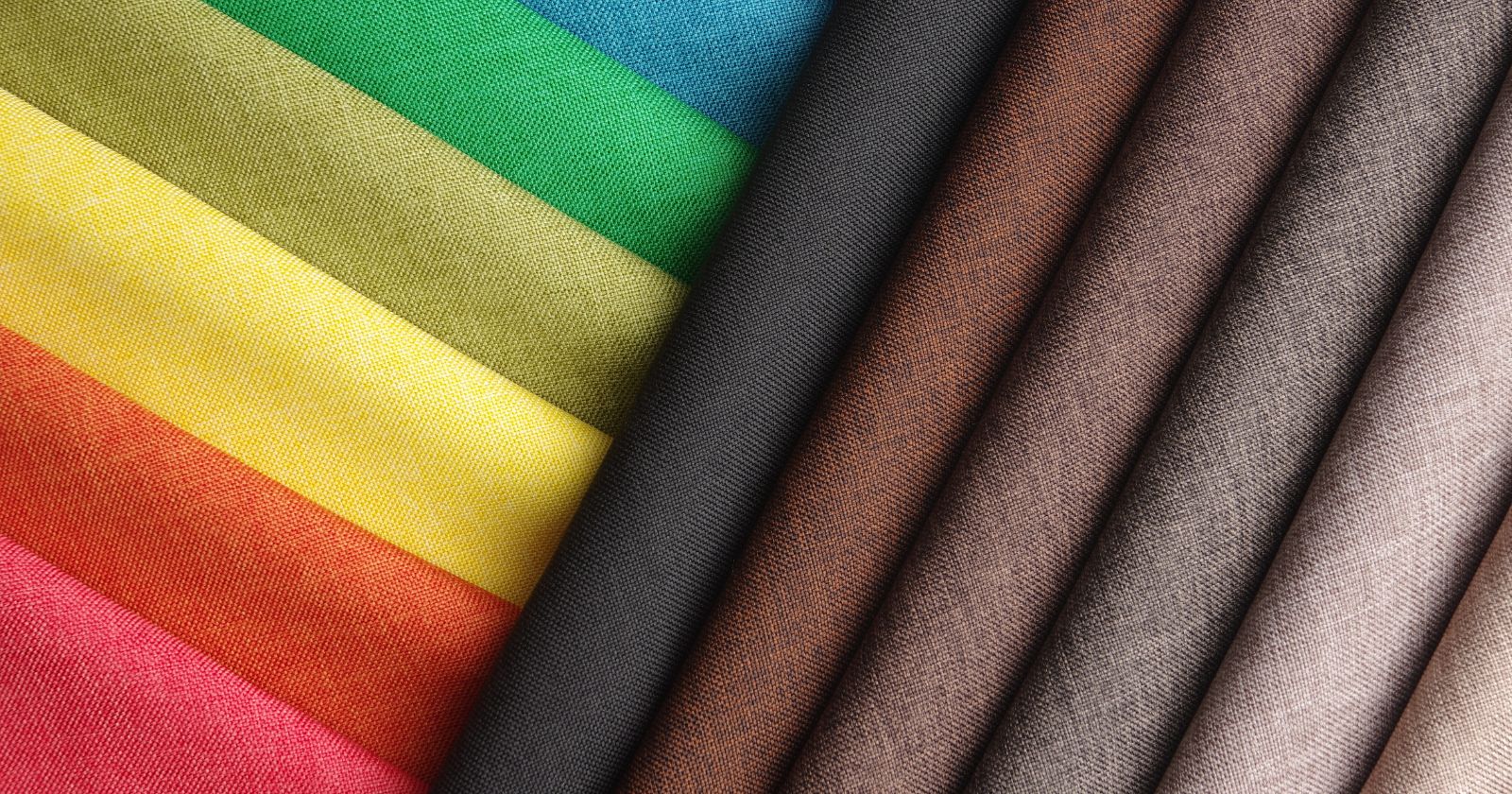Polyester, a synthetic fiber, and linen, a natural fabric, are both used in fashion and furnishings, but which is better out of these two fabrics? Let’s take a closer look.
Both linen and polyester fabrics are highly durable and offer excellent breathability and good moisture wicking. Polyester, a synthetic, is a warmer fabric, is more stretchy, and holds colors better. However, linen, made from the natural fibers of the flax plant, is significantly more environmentally friendly, especially when grown organically, making linen a better choice for long-term sustainability.
Need to know more? Check out our full comparison table below, then read on for more information about the uses, production, and sustainability of linen and polyester:
Linen vs Polyester Comparison Table
| Property | Linen | Polyester |
|---|---|---|
| Other Names | – | PET (polyethylene terephthalate) |
| Made From | Linen is made from the fibers of the flax plant. | Polyester is a synthetic fabric made using petroleum products, although it is increasingly made from recycled plastic bottles. |
| Advantages | Relatively environmentally friendly, breathable, with excellent durability. | Very high durability, with good breathability and moisture wicking makes polyester a very practical fabric. Can be mass produced at low cost. |
| Disadvantages | Wrinkles very easily. Costs more than comparable products made of cotton. | Significant environmental concern. |
| Uses | Clothing and furnishings, including tableclothes, napkins, curtains. | As a fabric, polyester is used widely in apparel and furnishings. Other uses include bottles and LCD displays. |
| Natural or Synthetic | Natural | Synthetic |
| Woven or Knitted | Woven | Either |
| Thread Count | 200-2,000 | 200-1,000 |
| Washing | Typically fine in the washing machine with cold water, but some garments may be dry-clean only (always check the label first) | Typically fine in the washing machine, but watch out for blends that need to be hand washed or washed in cooler water (always check the label first) |
| Drying | Some linen is tumble dry safe (check the label). When air drying, lay linen out flat rather than hanging to avoid losing the shape. | Normally fine in a tumble dryer with a low heat setting (check the label first) |
| Ironing | Turn inside out and iron on a hot setting using the steam setting | Can be ironed, typically on warm settings. Turn it inside out and use a covering cloth and steam to reduce direct heat. Too much heat can melt the garment. |
| Wrinkle Resistance | Wrinkles extremely easily | Don’t tend to wrinkle |
| Heat Retention | Poor | Medium |
| Moisture Wicking | Good | Good |
| Breathability | Very Good | Good |
| Stretchability | Low | Medium |
| Flammability (untreated) | Very high | High (tends to melt rather than burn) |
| Water-Resistance (untreated) | Low | Medium |
| Color-Fastness | Poor | Good |
| Strength | Good | Very Good |
| Durability | Excellent | Excellent |
| Drape | Stiff | Stiff |
| Softness | Medium (but becomes softer over time) | Medium |
| Environmental Impact Score (A is best, E is worst) | Conventional Linen = C, Organic Linen = A | Virgin Polyester = D, Chemically Recylced Polyester = B, Mechanically Recycled Polyester = A |
| Sustainability Issues | No chemicals are required to turn create linen from flax, and the flax plant does not require pesticides or fertilizers. Compared to most other fabrics, linen production is highly sustainable. | Polyester is a plastic. It does not degrade and requires significant energy, chemicals, and waste to create. We recommend only using recycled polyester products. |
| Vegan | Yes | Yes |
Linen vs Polyester: Production Methods
Linen is a natural fabric made from fibers of the flax plant. The plant is harvested and dried, and then the seeds are removed using a process called rippling. The plant is then retted, which is a process where the linen is submerged in water. The water causes the woody bits of the plant to rot, enabling the natural fibers to be separated out. These fibers are then turned into yarn and used to make linen fabric. The process of growing the plant and creating
Polyester, or PET, is a man-made fabric that is created using materials derived from petroleum. The petroleum is heated and the gas produced is then broken down into ethylene, which is further reacted with chlorine to form polyethelyne terephthalate (PET). The PET is drawn through small holes to form very thin polyester fibers. These fibers are then spun into yarns for creating polyester clothing or chopped up for use in applications like carpeting.
Linen vs Polyester: Uses
Both linen and polyester are used in clothing and furnishings. Polyester is a more popular choice for fashion, mainly due to its low cost, but both fabrics are used to make pants, shirts, dresses, and more. Items such as tablecloths, napkins, curtains and sheets can be made from either, although linen has the advantage of being a more luxurious fabric.
Linen vs Polyester Clothes
Aside from the look of the fabric, the differences between linen and polyester clothes mainly come down to three factors: cost, sustainability, and use. The first two are easy: if your deciding factor is cost, polyester will win every time; if you prefer a more sustainable fabric, it’ll be linen. Otherwise, it depends on how you’re going to use the fabric.
Linen clothes have the advantage in warm weather because linen is a more breathable fabric. Linen fibers also have similar moisture-wicking to the synthetic fibers of polyester. In warmer weather, polyester fabrics offer better heat retention, although it’s still not as good as a natural fiber like wool.
Linen vs Polyester Sheets
Linen sheets and pillowcases are highly durable and comfortable. Although they start out feeling a little rough, they’ll become a soft fabric over time – just give them a few washes. Linen’s hypoallergenic properties may also be a factor if you suffer from allergies. One downside is that linen wrinkles very easily, which can make it harder to achieve a smarter look on your bed.
Polyester sheets and pillowcases are just as durable as linen ones, although the look and feel of them is not as luxurious as linen or other natural fabrics. However, polyester bed sheets are cheaper and, like most synthetic fibers, considerably easier to care for.
Polyester vs Linen Curtains
Both polyester and linen make for relatively lightweight curtains. Of the two, linen is the more luxurious and breathable fabric, although it will need a lining to prevent the sun from fading it. Synthetic fabrics like polyester don’t fade in the same way and will be cheaper and easier to care for.
Polyester vs Linen Tablecloths
Both linen and polyester tablecloths are highly durable, and both should last for years with correct care. Linen offers a more luxurious finish, while polyester is more affordable and easier to keep clean.
Linen vs Polyester: Sustainability & Environmental Impact
Flax does not require a lot of pesticides or fertilizers to grow, and there are no chemical treatments needed during processing to create the linen fibers. The flax plant also needs less water than cotton plants to grow, meaning linen can be grown in more diverse locations without heavy watering. Untreated linen is biodegradable, and it’s a highly durable fabric, so it should last a long time. Typical linen has a low environmental impact, and this can be reduced considerably by buying organic linen, which is one of the most sustainable fabrics around.
Polyester, on the other hand, is made from fossil fuels, making it terrible for the environment. Additionally, its lower absorption rates for water mean it requires more water and energy to wash during its lifetime than linen and other natural fibers.
Our recommendation is that if you are interested sustainability, you should purchase linen over polyester (with the exception of products made from recycled polyester).
Linen vs Polyester: Cost
Linen is a little more expensive than the average fabric, and if you go organic, you can expect to pay a premium. Polyester is less expensive than linen and is normally the low-cost option.
Conclusion – Is Linen or Polyester Best?
We recommend organic linen. Not only is it more sustainable, but it’s very durable and breathable. Although it starts off stiff, it soon develops a soft feel. It does wrinkle easily, but other than that, it’s quite easy to care for. If you’re on a tight budget, polyester may suit you better, but we do recommend you stick to products made from recycled polyester.
Frequently Asked Questions
What is Polyester Linen?
Polyester linen refers to polyester that has been produced to mimic the look of natural linen. It is completely synthetic and is often confused with blended fabrics that include a mix of natural and synthetic fibers.
What does a linen polyester mix feel like?
Blended fabrics made from linen and polyester combine the properties of the two fabrics. The linen polyester mix will be softer and less likely to wrinkle than 100% linen and have a feel that is more natural than 100% polyester.
Does Polyester or Linen dry faster?
Polyester will dry much faster than linen. This is because linen, as a natural fabric, absorbs a lot more water than polyester. Polyester absorbs very little water and so less drying time is needed.


